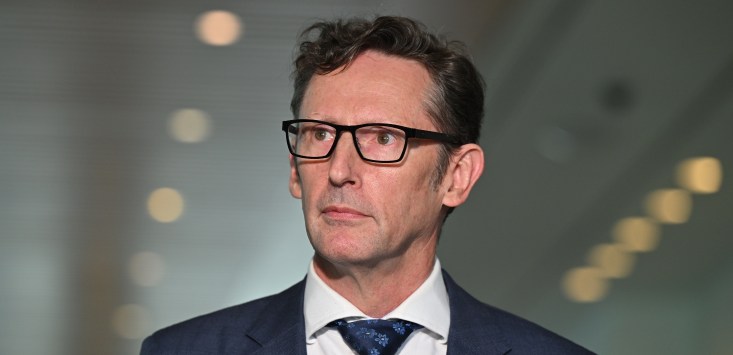
Assistant Treasurer and Minister for Financial Services Stephen Jones. Source: AAP Image/ Mick Tsikas
Insurance premiums could fall if insurers did a better job of recognising the disaster mitigation efforts taken by their policy-holders, Assistant Treasurer and Minister for Financial Services Stephen Jones says, mapping a pathway to more affordable coverage for households and small businesses alike.
Appearing at the Insurance Council of Australia Conference in Sydney on Thursday, Jones outlined the government’s approach to the insurance affordability crisis, which has seen some small business premiums rise 30% year-on-year.
Extreme weather events, underscored by a changing climate, have combined with surging household and commercial property values to make natural disasters exceedingly expensive for the insurance sector.
“On top of all this – because of supply constraints and the war in Ukraine – the cost of repair and replacement has gone up,” Jones said.
“These are the drivers of insurance costs and they are skyrocketing.”
Surging liabilities are making it more expensive for Australian insurers to seek reinsurance — capital sourced from the global market used to underwrite the insurers themselves.
Those reinsurance costs can make up 30% of the costs paid by the policy-holder, Jones said.
Admitting surging insurance costs are a global phenomenon, Jones said highlighting disaster mitigation efforts domestically could make it easier for Australian insurers to obtain reinsurance, which would flow through to more affordable premiums for homes and businesses on the ground.
Jones, who in September attended a meeting of European insurance leaders in Munich, said attendees were well aware of the small Queensland town of Roma and its flood levee.
The levee, which bore an initial cost of $28 million in 2012, has since prevented an estimated $130 million in damages to the local community.
Insurers should recognise the smaller mitigation efforts undertaken by policy-holders and local communities too, Jones said.
“Insurers can be quick to reflect risk in pricing,” he said.
“They need to do better to reflect private household mitigation in prices too.
“When a family puts bars on their windows to protect their home from theft, they usually see a dividend through cheaper insurance. The same thing should happen when people raise electrical outlets or elevate their house’s floor to protect it from flood water.
“When people put in the work to drive down risk, cheaper insurance is a just reward.”
Although the speech largely focused on the household sector, the key message is readily applicable to the small business sector, including early-stage founders who use their homes as a starting point for their enterprises.
Some work is already underway to boost awareness of effective mitigation efforts.
The National Emergency Management Agency is currently working with insurers to formulate a national private mitigation measure knowledge base — effectively a list of measures known to reduce disaster risk — so insurers can more easily recognise the positive steps taken by policyholders.
“It’s clear that we need to do a better job of ensuring that both public and private mitigation efforts are being recognised, both by insurers here at home, and reinsurers around the world,” Jones added.
Handpicked for you

Unicorn startup Pet Circle eyes pet insurance sector with “personalised” policies



COMMENTS
SmartCompany is committed to hosting lively discussions. Help us keep the conversation useful, interesting and welcoming. We aim to publish comments quickly in the interest of promoting robust conversation, but we’re a small team and we deploy filters to protect against legal risk. Occasionally your comment may be held up while it is being reviewed, but we’re working as fast as we can to keep the conversation rolling.
The SmartCompany comment section is members-only content. Please subscribe to leave a comment.
The SmartCompany comment section is members-only content. Please login to leave a comment.